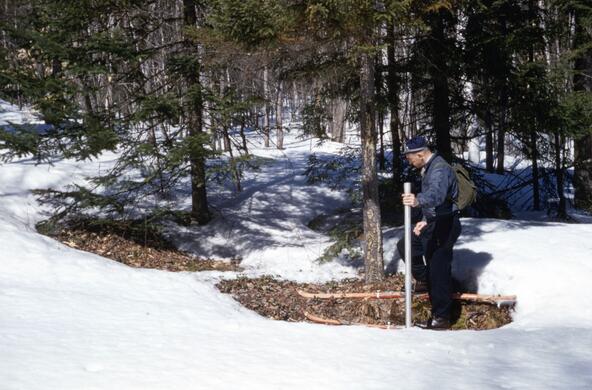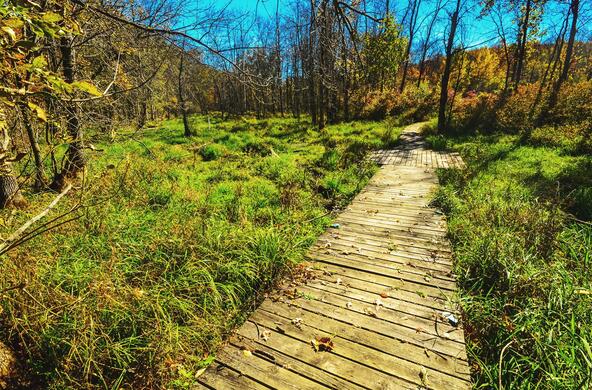Somewhere beneath your feet is a layer of soil or rock that is saturated with water, known as groundwater. It is one of the most poorly understood and underappreciated resources that we depend on. If your house has a well, your water comes from groundwater. At our house in Maine, we pump groundwater from a depth of about 160 feet.
Many of the massive agricultural fields that we see using spray irrigation are irrigating with groundwater. Problem is: we have only a rudimentary knowledge of how much groundwater there is and how fast it is regenerated in most regions.
Groundwater is derived from the deep seepage of rainwaters in regions where there is an excess of rainfall over the losses of water from evaporation and surface drainage. In some areas there is no excess, and thus, no recharge of groundwater. Unfortunately, this occurs most often in arid and semi-arid regions where we are most dependent on groundwater for daily life. Worldwide, about 10% of rainfall becomes groundwater, 30% is carried off by rivers and 60% is lost by the combined process which we call evapotranspiration—the loss of water vapor from plants and from the soil surface.
Needless to say, it is difficult to estimate the stock of groundwater. We usually know the depth of wells, which suggest that the average depth to groundwater is 2 to 7 meters. The lower limit of groundwater is more difficult to ascertain, and determined by the depth at which the temperature is too hot for liquid water to exist. Groundwater may extend to 2,000-3,000 m in some areas, but often deep groundwater is too salty for human use. Estimates of the amount of groundwater worldwide range from 4,200,000 to 22,400,000 km3, the second-largest pool of fresh water on Earth, after the polar ice packs.
It is easier to measure the depletion of groundwater, in areas where it is being removed faster than it is recharged so the level of water in wells is dropping. In the Central Valley of California, the level of groundwater has dropped by more than 2 cm/yr in recent decades. Clearly, the use of groundwater for agriculture in that region is not sustainable. Groundwater levels in India are also declining rapidly. Since the advent of NASA’s GRACE satellite, which measures small changes in the gravitational force on Earth, we’ve been able to measure groundwater over large areas by remote sensing.
In areas of west Texas and the Great Plains, underlain by the Ogallala Aquifer, there is essentially no modern recharge of groundwater. The same is true of the Mojave Desert in California, where the radiocarbon age of groundwater can be in excess of 10,000 years. The groundwater there is derived from deep seepage during the wetter conditions of the last glacial; it is essentially fossil groundwater. Globally, the mean age of groundwater is about 1,000 years, which is why it is so difficult to remediate groundwater pollution from the deep seepage or injection of contaminants.
Recent estimates suggest that only about 6% of groundwater is less than 50 years old. That is an estimate of groundwater that has been derived in modern times and potentially renewable.
Unfortunately, groundwater is out of sight, out of mind. We assume the wells will flow. But, the current world extraction of groundwater is such that many arid regions will deplete groundwater within a few decades.
References
Bodnar, R.J., T. Azbej, S.P. Becker, C. Cannatelli, A. Fall and M.J. Severs. 2013. Whole Earth geohydrologic cycle, from the clouds to the core: the distribution of water in the dynamic Earth System. Geological Society of America, Special Paper 500, pp. 431-461.
Doll, P. and K. Fiedler. 2008. Global-scale modeling of groundwater recharge. Hydrology and Earth System Sciences 12: 863-885.
Famiglietti, J.S., M. Lo, S.L. Ho, J. Bethune, K.J. Anderson, T.H. Syed, S.C. Swenson, C.R. de Linage and M. Rodell. 2011. Satellite measure recent rates of groundwater depletion in California’s Central Valley. Geophysical Research Letters 38:
Fan, Y., H. Li and G. Miguez-Macho. 2013. Global patterns of groundwater table depth. Science 339: 940-943.
Gleeseon, T., K.M. Befus, S. Jasechko, E. Luijendijk and M. Bayani Cardenas. 2015. The global volume and distribution of modern groundwater. Nature GeoScience doi: 10.1038/ngeo2590
Kanag, M. and R.B. Jackson. 2016. Salinity of deep groundwater in California: Water quantity, quality and protection. Proceedings of the National Academy of Sciences U.S. 113: 7768-7773.
Rodell, M., I. Velicogna and J.S. Famiglietti. 2009. Satellite-based estimates of groundwater depletion in India. Nature 460: 999-1002.
Scanlon, B. R. et al. 2012. Groundwater depletion and sustainability of irrigation in the US High Plains and Central Valley. Proceeedings of the National Academy of Sciences US. 109: 9320-9325.
Schlesinger, W.H. and S. Jasechko. 2014. Transpiration in the global water cycle. Agricultural and Forest Meteorology 189/190:115-117.
Slutsky, A.H. and B.C. Yen. 1997. A macro-scale natural hydrologic cycle water availability model. Journal of Hydrology 201: 329-347.







